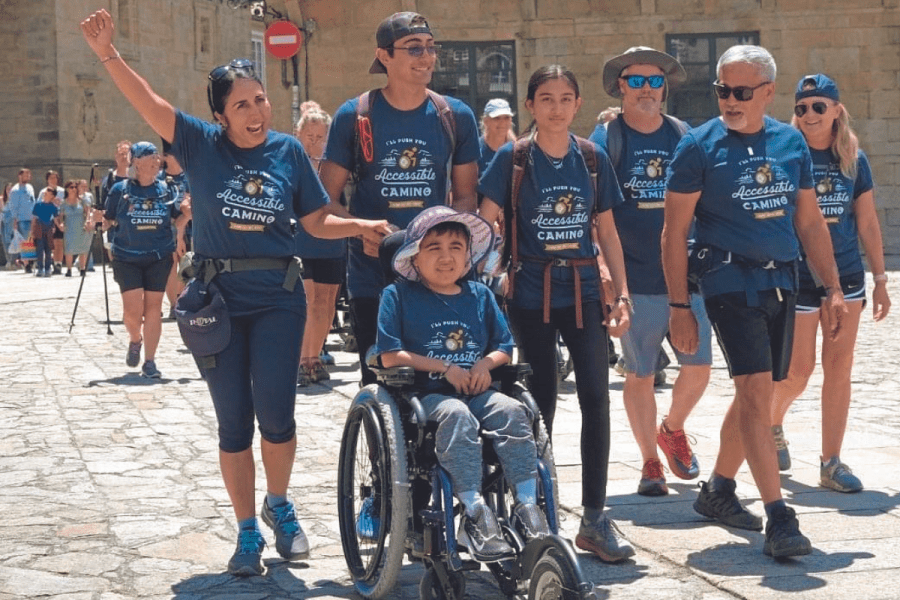In 2022, author and MD Tanmeet Sethi set out to walk part of the Camino Trail in Spain with her son, Zubin, who has a fatal condition and is in a wheelchair. People told them it couldn’t be done, but they proved them wrong. Here’s what she learned…
Your child will not walk. Your child will not run. And then his heart and lungs will fail. This is the story I was left with on an otherwise sunny day in September more than a decade ago. Yes, there was a diagnosis attached to it – Duchenne muscular dystrophy, a degenerative and fatal illness, like ALS in young boys. And yes, there were other words about treatments – mostly, the lack thereof.
But all I came back with from that afternoon was my heart’s understanding that everything my son had would be taken away from him until he was taken away from us. When you are faced with the unimaginable, you can choose to shrink away or move into the world and find a way to feel power again.
I imagine many write off St Augustine’s famous quote “solvitur ambulando” (it is solved by walking) as too trite or easy. And so may you. But trust me, walking has far more benefits than just the physical. I tell my patients daily, ‘If your body doesn’t move, neither will your mind’.
In June 2022, my family of five joined a group of almost 50 other individuals to walk the last 100km of the Camino de Santiago, a famed pilgrimage route of St James, in Spain. Thousands of pilgrims, as they are called, walk part or all of this almost 800km route every year. But our walk was different than the typical pilgrimage.
We had six “captains”, as they were called. The captains were individuals in wheelchairs, including my son, the youngest, who rolled as they were able, with all of us pushing, pulling and supporting them. It was a trip organised and guided by I’ll Push You (illpushyou.com), a U.S.-based organisation founded by two lifelong friends, one in a wheelchair and one able-bodied, who walked and rolled the Camino in its totality and now guide others in wheelchairs to access this experience.
Often individuals in the group would comment to our family how “inspiring” we were. They were moved by our family’s unified purpose and resilience. But I would chuckle each time. They were the inspiration. They were solo pilgrims who could have walked faster and further on the Camino on their own. But they chose to walk, push and pull strangers in wheelchairs instead. They chose journey over outcome – something a long walk will always teach you.

Sahaj, Steve and Zubin rolling alongside Justin (one of the I’ll Push You founders), pushed by Tim
A bigger story
We walked together for six days, over Roman roads, steep ravines and cobblestoned paths. We walked, we cried, we laughed and most of all, we moved with one common purpose. I will never forget the Spanish policeman that saw our large group approaching an incredibly steep and narrow Roman road on the way. ‘No puedes ir alli. No es para sillas de ruedas,’ he said (‘You can’t go there. It’s not for wheelchairs’). But go there we did.
That was just one of the moments of triumph for our group. A moment of exhilarating joy for our captains who felt like they had accomplished something they had never thought possible. You see on that tragic September day of my son’s diagnosis, I thought so much was not possible. All the dreams I had of being a mother were shattered. My son would never walk, play sports, go to college, have his own family. But now I know that the dreams I have remade are far bigger than those smaller ones that were broken. Now my dreams are like this Camino – they are about triumph, resilience and connection. They are about the possible.
All humans want to expand into a story bigger than the small stories of suffering you are given. Suffering makes your lens on life narrow, and experiences like this journey, especially in community, can move you into a bigger story. We walked those trails with strangers who then became family. We felt our bodies on the earth, allowing us to feel what was in our bodies. Grief, frustration, anger – all that comes with a challenge like my son’s. And then we held those emotions lovingly as we walked into a larger story.
On the last day when we walked into that grand, majestic square in Santiago de Compostela, all of us interlocking hands with the captains, there was not only not a dry eye in our group, the entire square was cheering and weeping for us. But I know they rejoiced not only for us. They rejoiced for themselves, for the vision of what is possible, for the knowing that there is always more than one story.

Triumphantly walking into the square in Santiago de Compostela to lots of cheers — and tears.
Weeping for joy
My husband and I wept with joy and grief, all intertwined in the same moment. And we knew our son would weep as he did, after this accomplishment. Throughout the trip, he remarked on how this was the first experience that felt centred on his and the other captains’ needs rather than accommodating them to the able-bodied world. But the biggest surprise was how much it also fundamentally changed and inspired my two other kids.
My oldest son is returning this year to do it again with new captains that he has never met. Staying stuck in one place, either in your body or mind, only constricts you to a narrow story. Moving forward, especially with others, brings you to a new understanding. If I could talk to St Augustine, I would say not all is solved. The challenging emotions are not gone magically. But he was right that walking can change everything. It moves you into a larger space that allows those difficult truths to be held with more ease. We walked into a larger story and so can you.
Tanmeet Sethi is an integrative mental health and psychedelic medicine physician, TEDx speaker and author of Joy Is My Justice (£19.65, Hachette), and the Substack newsletter Beautiful and Brutal. Find out more about her work at tanmeetsethimd.com and follow her at instagram.com/tanmeetsethimd. For more about I’ll Push You, visit illpushyou.com.
Words: Tanmeet Sethi. Images: Tim Bryant for Camino Pics







